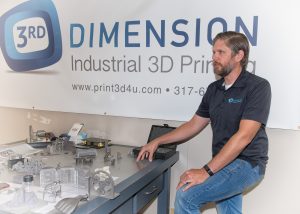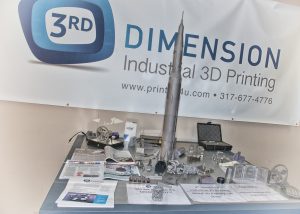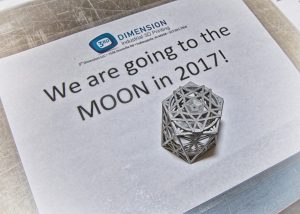The Next Industrial Revolution is Underway
Writer / Janelle Morrison • Photographer JJ Kaplan
 We are on the verge of what may be a new industrial revolution, and Additive Manufacturing (AM) or “3D printing” is transforming the way that the manufacturing industry and engineers are looking at the production of their designs. The possibilities are allowing for new innovation and a resurgence of human creativity.
We are on the verge of what may be a new industrial revolution, and Additive Manufacturing (AM) or “3D printing” is transforming the way that the manufacturing industry and engineers are looking at the production of their designs. The possibilities are allowing for new innovation and a resurgence of human creativity.
The AM machines and the technology that employs them range from basic consumer designs to heavy industry production. The different types of AM machines have varying degrees of capabilities and work with different types of materials such as nylon, glass and titanium. These machines can print objects with any complex geometry going beyond the limitations of conventional manufacturing.
One of the driving forces behind the new industrial revolution is Zionsville resident Bob Markley, owner of 3rd Dimension Industrial 3D Printing. Markley’s company is an industry-leading Direct Metal Printing provider in North America. With the core of their engineering team’s experience centered around the racing industry, they understand that time and precision are of the utmost importance for their customers’ jobs. Their highly skilled team of engineers has the expertise to take their clients from prototyping to manufacturing. 3rd Dimension produces prototypes and end-use parts with highly complex geometries that may not be a good fit for traditional machining.
Markley took us on a tour of his 4,500 sq. ft. facility that houses his team of six highly trained team members. Markley is preparing to add more team members and is looking for more space as their production contracts are increasing.
While he could not show most of what they create due to confidentiality and security regulations, the showpieces that we saw were remarkable examples of human ingenuity. Many of the pieces appeared rather delicate and intricate in design but were virtually indestructible. Markley said they work a lot with titanium because it’s a high strength material typically used in aerospace, automotive, sporting goods and medical devices.
“We are producing near full density metal,” Markley explained. “If we are working with titanium, we start with the titanium powder and basically micro-weld where we want the part to be. It’s all done digitally. We start with the CAD file, bring it in to our program and essentially do some  additional CAD work to develop all of the support structure. We do have a traditional machine shop in house to do more of the traditional finishing processes. There are still limitations to the technology, but as long as you understand those limitations, we can work around it.
additional CAD work to develop all of the support structure. We do have a traditional machine shop in house to do more of the traditional finishing processes. There are still limitations to the technology, but as long as you understand those limitations, we can work around it.
“The AM in metals has been around since the mid-2000s. AM has been around for 30 years. We are starting to see some real progress in the projects that we’re working on now. We are five years out from these parts going into production. We are still doing a lot of proof of concept, proofing out the materials and proofing the process. We have to validate the materials and the machines, and there’s a lot statistical analysis that goes into the development process.
“If you think about traditional manufacturing, we’ve been developing that over thousands of years. We’re seeing a lot of advancements, not only in manufacturing technology but also in how we control the data, the files, how we translate those, and how we pass all of the information from the engineer to the manufacturing floor. There is a lot of work going on with that right now.”
Markley explained that his company has obtained its AS9100 certification. AS9100 is an aerospace standard, established by the aerospace industry to satisfy Department of Defense, NASA and FAA quality requirements.
Markley’s clients included companies like the Rolls-Royce Corporation quite a bit of aerospace clients and some automotive and machine suppliers.
One of the projects created by Markley and his team will be heading to the Moon as part of the Google Lunar XPRIZE mission. Created in 2007, the mission of the Google Lunar XPRIZE is to incentivize space entrepreneurs to create a new era of affordable access to the Moon and beyond.
The competition’s $30 million prize purse will be awarded to teams who are able to land a privately funded rover on the Moon, travel 500 meters and transmit back high definition video and images. The first team that successfully completes this mission will be awarded the $20 million Grand Prize. The second team to successfully complete the mission will be awarded $5 million. To win either of these prizes, teams must prove that 90 percent of their mission costs were funded by private sources. Teams have until the end of 2016 to announce a verified launch contract to remain in the competition and complete their mission by the end of 2017.
 Carnegie Mellon University designed and built a four-wheeled lunar rover that will go to the Moon. The university contracted Markley’s company to design and build eight “time capsules” that will contain the history of mankind. Four of the eight will be attached to the underside of one of the landers that will go up to the Moon during the Google Lunar XPRIZE projected to launch in 2017. The remaining four capsules will be on museum tours across the world.
Carnegie Mellon University designed and built a four-wheeled lunar rover that will go to the Moon. The university contracted Markley’s company to design and build eight “time capsules” that will contain the history of mankind. Four of the eight will be attached to the underside of one of the landers that will go up to the Moon during the Google Lunar XPRIZE projected to launch in 2017. The remaining four capsules will be on museum tours across the world.
“Weight was very critical on this project,” Markley said. “It cost $8,000 per ounce to send something up to the Moon. The capsules are made of aluminum and made to reside on the Moon for all of time.”
Markley studied mechanical engineering technology at Purdue University and has a MBA from Butler University. He had been an engineer in the racing industry prior to his current career. He and his wife, Arielle, have a 1-year-old son and live in Zionsville.
Markley sits on an advisory board for the Purdue Manufacturing Extension Partnership (MEP) that provides high value, affordable solutions to help businesses increase profitability. As advocates for Indiana’s thousands of manufacturers, their staff leverages resources in both the public and private sectors to help identify areas of improvement, streamline processes and ultimately increase competitiveness.
A strong advocate for developing the manufacturing workforce, Markley and his wife both support programs that promote educating young students of the advantages of having a high-skill, high-pay job and about the training and certification programs that are available to them.
“With the skilled and knowledgeable work force getting near retirement, we have a huge shortage of skilled workers, and we have jobs that need fulfillment,” Markley observed. “There are a lot of local programs in the area as well. The Gene Hass Foundation has a training facility in Lebanon, Indiana, and is partnered with Vincennes University.”
Markley concluded, “We’re still in the infancy of the additive industry, but I think we’re going to see a huge jump in the next three to five years as we’re better able to monitor our equipment and are better able to process the data that we’re generating. It’s really going to open a lot of doors to what we can use this for.”






